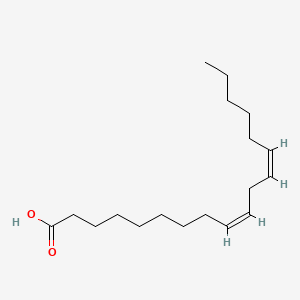Linoleic acid
Linoleic acid is a lipid of Fatty Acyls (FA) class. Linoleic acid is associated with abnormalities such as Diabetes Mellitus, Non-Insulin-Dependent, Metabolic syndrome, Obesity, Chronic Obstructive Airway Disease and Pneumonia. The involved functions are known as Insulin Resistance, Inflammation, Synthesis, Pathological accumulation of air in tissues and cytokine biosynthesis. The associated genes with Linoleic acid are TNF gene, CCL2 gene and TLR4 gene. The related lipids are palmitoleic acid, nervonic acid and Sphingolipids.
Cross Reference
Introduction
To understand associated biological information of Linoleic acid, we collected biological information of abnormalities, associated pathways, cellular/molecular locations, biological functions, related genes/proteins, lipids and common seen animal/experimental models with organized paragraphs from literatures.
What diseases are associated with Linoleic acid?
Linoleic acid is suspected in Obesity, Diabetes Mellitus, Non-Insulin-Dependent, Metabolic syndrome, Chronic Obstructive Airway Disease, Pneumonia and other diseases in descending order of the highest number of associated sentences.
Related references are mostly published in these journals:
| Disease | Cross reference | Weighted score | Related literature |
|---|
Possible diseases from mapped MeSH terms on references
We collected disease MeSH terms mapped to the references associated with Linoleic acid
PubChem Associated disorders and diseases
What pathways are associated with Linoleic acid
There are no associated biomedical information in the current reference collection.
PubChem Biomolecular Interactions and Pathways
Link to PubChem Biomolecular Interactions and PathwaysWhat cellular locations are associated with Linoleic acid?
There are no associated biomedical information in the current reference collection.
What functions are associated with Linoleic acid?
Related references are published most in these journals:
| Function | Cross reference | Weighted score | Related literatures |
|---|
What lipids are associated with Linoleic acid?
Related references are published most in these journals:
| Lipid concept | Cross reference | Weighted score | Related literatures |
|---|
What genes are associated with Linoleic acid?
Related references are published most in these journals:
| Gene | Cross reference | Weighted score | Related literatures |
|---|
What common seen animal models are associated with Linoleic acid?
There are no associated biomedical information in the current reference collection.
NCBI Entrez Crosslinks
All references with Linoleic acid
Download all related citations| Authors | Title | Published | Journal | PubMed Link |
|---|---|---|---|---|
| Vanden Heuvel JP et al. | Differential activation of nuclear receptors by perfluorinated fatty acid analogs and natural fatty acids: a comparison of human, mouse, and rat peroxisome proliferator-activated receptor-alpha, -beta, and -gamma, liver X receptor-beta, and retinoid X receptor-alpha. | 2006 | Toxicol. Sci. | pmid:16731579 |
| Matsusue K et al. | A highly toxic PCB produces unusual changes in the fatty acid composition of rat liver. | 1997 | Toxicol. Lett. | pmid:9175845 |
| Alghazeer R et al. | Cytotoxicity of oxidised lipids in cultured colonal human intestinal cancer cells (caco-2 cells). | 2008 | Toxicol. Lett. | pmid:18625293 |
| Shchepinov MS et al. | Isotopic reinforcement of essential polyunsaturated fatty acids diminishes nigrostriatal degeneration in a mouse model of Parkinson's disease. | 2011 | Toxicol. Lett. | pmid:21906664 |
| Mitchell LA et al. | Linoleic acid, cis-epoxyoctadecenoic acids, and dihydroxyoctadecadienoic acids are toxic to Sf-21 cells in the absence of albumin. | 2002 | Toxicol. Lett. | pmid:11814707 |
| Moran JH et al. | Cytotoxicity of linoleic acid diols to renal proximal tubular cells. | 1997 | Toxicol. Appl. Pharmacol. | pmid:9299596 |
| Moran JH et al. | Linoleic acid prevents chloride influx and cellular lysis in rabbit renal proximal tubules exposed to mitochondrial toxicants. | 2001 | Toxicol. Appl. Pharmacol. | pmid:11714247 |
| Yu WK and Wells PG | Evidence for lipoxygenase-catalyzed bioactivation of phenytoin to a teratogenic reactive intermediate: in vitro studies using linoleic acid-dependent soybean lipoxygenase, and in vivo studies using pregnant CD-1 mice. | 1995 | Toxicol. Appl. Pharmacol. | pmid:7878664 |
| Moran JH et al. | Analysis of the toxic effects of linoleic acid, 12,13-cis-epoxyoctadecenoic acid, and 12,13-dihydroxyoctadecenoic acid in rabbit renal cortical mitochondria. | 2001 | Toxicol. Appl. Pharmacol. | pmid:11298501 |
| Slim R et al. | The role of methyl-linoleic acid epoxide and diol metabolites in the amplified toxicity of linoleic acid and polychlorinated biphenyls to vascular endothelial cells. | 2001 | Toxicol. Appl. Pharmacol. | pmid:11243918 |
